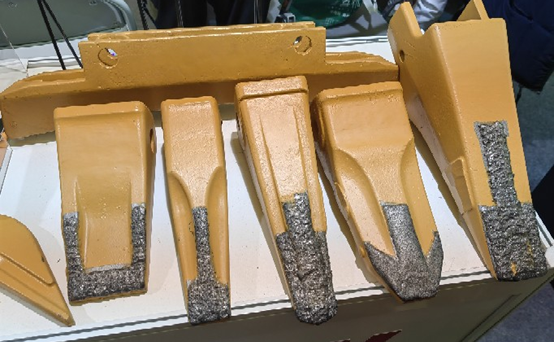Hardfacing is a metal surface engineering process in which a layer of wear-resistant alloy is deposited onto a metal substrate by welding, cladding, or thermal spraying.
The goal is to significantly improve the wear resistance, corrosion resistance, impact strength, and high-temperature performance of critical components.
Unlike traditional heat treatment—which changes the bulk material—Hardfacing enhances only the surface. The result is a component that maintains a tough, ductile core while achieving a surface hardness of HRC 45–70.
This technology is widely used in mining, construction, energy, petrochemical, and heavy manufacturing industries.

The Principle of Hardfacing
The core principle of Hardfacing is simple yet powerful:
By applying thermal energy (via arc, plasma, or laser) to melt filler metals or alloy powders, a metallurgically bonded, high-performance surface layer is formed on the substrate.
This “hard skin” effectively resists several forms of wear:
• Abrasive wear: friction and cutting from sand, ore, or dust particles;
• Impact wear: high-energy strikes from excavator teeth or crusher hammers;
• Corrosive wear: exposure to acids, alkalis, or other chemical environments;
• High-temperature wear: oxidation and degradation in turbines or furnaces.
The deposited layer typically contains hard carbides (Cr₇C₃, WC, TiC) and strengthening elements such as Cr, Ni, Mo, and Co, creating a dense, wear-resistant microstructure.
Common Hardfacing Processes
1.Shielded Metal Arc Welding (SMAW)
- Features: simple equipment, flexible, suitable for field repair;
- Filler materials: high-carbon, high-chromium alloy electrodes.
2.Flux-Cored Arc Welding (FCAW)
- Features: semi- or fully automated, high deposition rate, efficient for large areas;
- Advantages: good bonding, low dilution, consistent quality.
3.Gas Metal Arc Welding (GMAW/MIG/MAG)
- Features: stable arc, low spatter, smooth bead appearance;
- Applications: precision components, molds, structural reinforcements.
4.Tungsten Inert Gas Welding (TIG)
- Features: precise control, minimal heat input, small distortion;
- Applications: valve seats, mold edges, medical equipment.
5.Plasma Transferred Arc (PTA) Welding
- Features: dilution <5%, dense cladding, suitable for multilayer deposition;
- Applications: energy equipment, high-performance valves, pump screws.
- Features: concentrated energy, minimal deformation, high automation;
- Advantages: excellent surface quality and bonding strength.
Hardfacing Material Classification
The welding consumables used in Hardfacing can be categorized according to the substrate and application:
• Iron-based alloys: low cost, high impact resistance, suitable for general wear parts.
• Nickel-based alloys: corrosion-resistant, high temperature-resistant, commonly used in the chemical and energy sectors.
• Cobalt-based alloys (e.g. Stellite): maintain hardness at high temperatures, used for valves, turbine blades.
• Carbide reinforced materials (WC, Cr₃C₂, TiC): ultra-high wear resistance, used in mining and mixing equipment.
Advantages of Hardfacing Technology
- Extended service life – surface durability improved 3–10×;
- Reduced maintenance cost – parts can be rebuilt instead of replaced;
- Less downtime – longer maintenance intervals and higher reliability;
- Improved equipment performance – enhanced stability under harsh conditions;
- Eco-friendly and resource-efficient – supports remanufacturing and waste reduction
Typical Applications of Hardfacing
- Mining & Metallurgy: crusher hammers, screens, screw conveyors;
- Construction & Earthmoving: bulldozer blades, excavator teeth, mixing paddles;
- Energy & Chemical: high-temperature valves, pump bodies, impellers;
- Agricultural Equipment: plowshares, tiller blades, grain augers;
- Molds & Manufacturing: dies, forming tools, wear edges.
Industry data: Applying Hardfacing can extend the average component lifespan by more than 400%, providing substantial economic benefits.
Hardfacing technology, with its excellent economy and reliability, has become an important means of life extension, repair and performance improvement in the manufacturing industry. Through the scientific selection of hardfacing process, materials and parameter control, enterprises can greatly improve the stability of equipment, reduce production costs and realize sustainable competitive advantage.
Shanghai Duomu Industrial Co., Ltd. specializes in “surface engineering and Hardfacing” solutions, for mining, energy, machinery manufacturing industry to provide a comprehensive wear-resistant repair services.
Welcome to contact us for customized hardfacing solutions.
Post time: Oct-31-2025